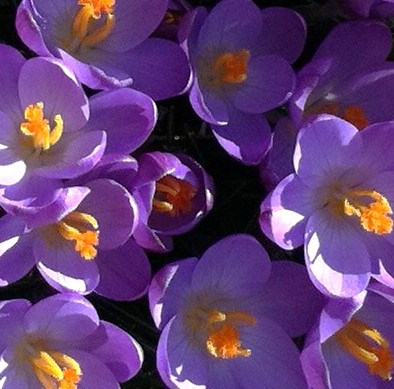Snow crocus, Crocus tommasinianus, is deer resistant, reliably perennial, flowers nonstop from midwinter through early spring, and provides bees an early source of nectar and pollen. Cheerful drifts of Tommies usually flower sequentially in shades of lilac, rose, lavender, purple, and violet in my meadow for 4-6 weeks from about mid-February to the end of March. The Tommies not only herald the end of winter, but also my birthday (2 March), International Women’s Day (8 March), Vita Sackville-West’s birthday (9 March). By Saint Patrick’s Day the Tommies most always have turned the meadow into waves of amethyst, blooming straight through the Vernal Equinox and March madness. But the Tommies very nearly missed their cue this year; as the snow finally melted last week, the species and cultivars emerged within days of one another, filling the meadow with purple haze, just in time to welcome the Vernal Equinox on Thursday.
- Crocus tommasinanus was first described, named, and illustrated by William Herbert (1778–1847) in the Journal of the Horticultural Society of London in 1847. A botanist, botanical illustrator, poet, and clergyman, Rev. Herbert described and named a total of 949 bulbous plants, including more than 100 species and forms of Crocus, about which he wrote an illustrated history. However, his passion was for Amaryllis and its tropical relatives, to which the botanist devoted his standard work Amaryllidaceae, 1837.

- Rev. Herbert named Crocus tommasinianus in honour of Muzio Giuseppe Spirito de Tommasini (1794 – 1879), a Tireste botanist celebrated for his work on Dalmation flora. The species bears lilac-purple flowers in winter on native hillsides and woods of southern Hungary, north west Bulgaria, Croatia, Serbia, Bosnia, Herzegovina, and Montenegro
- C. tommasinianus ‘Roseus’ is first to appear in my meadow, early, about the same time as the species. It is the most dramatic of the cultivars in bud, offering a two tone effect: creamy outer petals with mulberry-rose reverse. Fully open, flowers resemble stars, rosy-violet with hints of cream, topped with orange stamens.


- A bit like the species on steroids, its large, chalice shaped blooms of rich lavender open to reveal prominent orange stamens.

- Crocus species and cultivars like ‘Barr’s Purple’ provide plenty of nectar and pollen for foraging honey bees early in the season.

- Crocus tommasinianus ‘Ruby Giant’ stars in the snow crocus show, providing a final wave of color in a rich, deep violet.
Order Crocus tommasinianus and its cultivars by the 100 for fall planting. The corms are tiny. Tommies are most effective planted in turf. Dig shallow 10-12″ circles; flip turf back with a spade. Plant in groups of 10-20. Fill all holes with bulbs before replacing clods of turf. Squirrels will not bother bulbs in turf. Skip the first mowing in May to allow the foliage to ripen for at least 6 weeks after flowering. Mow around the crocus foliage; mow off after mid May.
I order bulbs from Van Engelen.












